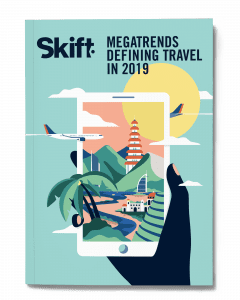Restaurant Megatrends 2019: The Battle for Loyalty Takes Place on Multiple Fronts

Photo Caption: Subway, like other brands, uses its app to push loyalty. But that's not the only way to have return customers.
Skift Take
For restaurants, loyalty is not just a service to thank repeat customers. It’s an incredibly effective data acquisition strategy that is an increasingly vital component of any restaurant’s operations, from discount-driven chains to fine dining experiences.
We've just released our annual industry trends forecast, Skift Restaurant Megatrends 2019. You can read about each of the trends on Skift Table as well as download a copy of our magazine here.
Lettuce Entertain You, a Chicago-based restaurant group that includes over 60 different restaurant brands, is no stranger to loyalty programs. The 47-year-old company has offered a diner rewards program since the 1990s, but, until recently, it primarily existed as a physical card-based program.
Five years ago, Jennifer Bell, Lettuce Entertain You’s executive vice president of marketing, sought to change that. Bell led an initiative within the company to ditch the pen-and-paper program that it had been running for decades in favor of a digital loyalty app, got rid of a $25 charge to sign up for the program, and watched member count grow exponentially as a result.
Speaking in October 2018 at TechTable, a restaurant industry conference, Bell told the audience that the revamped loyalty program now counts 300,000 users on its platform (up from 7,500 when it first relaunched). User engagement has gone up dramatically with the digital program, and average checks are significantly higher among loyalty members.
“I’m not going to lie, it’s challenging, costly, and maintenance is tough,” Bell said of implementing the program. “But it is worth it.”
In a future where technology informs every inch of restaurant operations, the punch card trope of a restaurant loyalty program is disappearing fast. Whether the programs are built in-house or through a third party vendor, modern loyalty solutions are driving sales and producing valuable customer data that is integral to building a personalized hospitality experience.
Harnessing Loyal Customers
Over the past year, restaurant chains large and small have been focused on launching new digital loyalty programs. Chipotle started testing a loyalty offering in three markets in September 2018 with the intent for a nationwide rollout in 2019. Kentucky-based Italian chain Fazoli’s launched a loyalty program in late 2017 and those members now account for 15 percent of sales in some locations.
Even Starbucks, often regarded as building the gold standard for loyalty programs in the restaurant industry, acknowledged that it hasn’t yet fully tapped into the program’s potential to drive sales and engagement. In the company’s November 2018 earnings call, Starbucks’ head of marketing, Matthew Ryan, said that while the company counted 15.3 million active members in its loyalty program, Starbucks has only “just begun” to fully leverage those relationships.
“Remember that we’re not in a business of creating digital relationships for digital relationships’ sake,” Ryan told analysts. “They’re an enabler for us to communicate and talk to our customers.”
In many cases, loyalty offers a better solution to drive sales and produce more effective marketing. Fazoli’s digital marketing manager Will Hanrahan told Skift Table that the company’s year-old digital loyalty program has begun to inform the company’s overall marketing strategy. Engagement and coupon redemption rates are higher through the loyalty app versus email and print marketing campaigns, and when the chain needs a sales boost, leadership increasingly turns to Fazoli’s loyalty app to push out promotions before other marketing channels.
Like Fazoli’s, grilled chicken chain El Pollo Loco has also discovered the power of committed loyalty members. “As with delivery, we are now focusing on optimizing our loyalty program, which in this case, means determining how to translate the robust purchase history data into personalized communication and incremental sales,” El Pollo Loco’s CEO Bernard Acoca said on the company’s third-quarter earnings call.
After observing how loyalty drives engagement, the nationwide restaurant chain also plans to leverage its 1.1 million loyalty members to push marketing around delivery and significantly grow the chain’s delivery sales.
More Than an App Download
Native apps aren’t the only way that restaurants are driving loyalty. Third-party technology vendor LevelUp — which was acquired by Grubhub earlier this year — offers a customer-facing loyalty app where diners can access dozens of restaurant rewards at once. Now that Grubhub owns LevelUp, the company is aiming to become a one-stop shop for all of a restaurant’s technology needs.
Credit card providers like American Express and Chase offer robust dining rewards programs that aren’t necessarily driven by discounts. World-renowned fine dining institution Eleven Madison Park has a longstanding loyalty relationship with American Express that is driven by exclusive, member-only experiences. The restaurant’s seasonal pop-ups, EMP Summer House and EMP Winter House, are only accessible to American Express credit card holders.
The most engaging restaurant loyalty programs will be the ones that work best for all parties involved. Digitally driven, personalized experiences are key for diners, while restaurant operators need programs that seamlessly integrate with the rest of their technology stack, from the point-of-sale system to delivery and online ordering.
Download Your Copy of Skift Megatrends 2019


